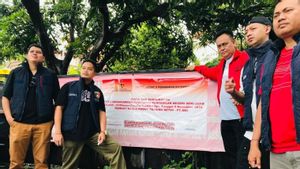JAKARTA - The engine cooling issue has forced NASA on Monday, August 29 to delay at least four days of launch from a conosal new rocket debut test that is planned to be used for future astronaut flights back to the moon.
The space agency declined to set the right schedule to retry the mission's launch, dubbed Artemis I. However, according to senior NASA officials at a press conference hours after the cancellation, a second attempt is still possible this Friday this week, depending on the results of further data analysis.
"If engineers can resolve the issue on the launch pad in the next 48 to 72 hours, Friday will definitely be played," Michael Sarafin, NASA's Artemis mission manager told the media.
The planned journey marked the beginning of NASA's much-proud Artemis-to-month and Mars program, as the successors to the 1960s and 70s Apollo missions, and the first journey of Space Launch Vehicle (SLS) rockets and Orion astronaut capsules.
Safety is always first. Following today's #Artemis I launch attempt, @NASAArtemis teams are working through an issue with engine number 3, and expect to give a news briefing later today. Stay tuned for broadcast details. https://t.co/z1RgZwQkWS pic.twitter.com/BxpIOGyId9
— NASA (@NASA) August 29, 2022
The mission calls for an unmanned six-week Orion capsule test around the moon and back to Earth for a landing in the Pacific.
The damage on Monday emerged as a rocket fuel tank filled with super-cold liquid oxygen and hydrogen propellant at the Kennedy Space Center in Cape Canaveral, Florida.
The launch team has started a "conditioning" process to cool four major SLS engines, but one machine has failed to cool as expected, NASA said, as quoted by Reuters. The flight had to be canceled two minutes after the scheduled launch time.
The launch delay that comes at an end is a routine in the space business. Monday's incident itself is not a direct indication of a major setback for NASA or its main contractor, Boeing Co for SLS and Lockheed Martin Corp for Orion.
"We didn't launch until it was true," NASA head Bill Nelson said in a webcast interview after takeoff was canceled. "It's a very complicated machine, a very complicated system, and all of that has to work. You don't want to turn on the candle until it's ready for use."
However, the delay disappointed thousands of spectators gathered on the beach around Cape Canaveral, with binoculars in their hands. US Vice President Kamala Harris also recently arrived at the center of space, to join the crowd of invited guests attending the event.
The flight was meant to put a vehicle weighing 5.75 million pounds through its move on a tight demonstration flight, pushing the design limit, before NASA deems it reliable enough to carry astronauts on the next targeted flight for 2024.
Considered the world's most powerful and complex rocket, the SLS represents the largest new vertical launch system US space agency has built since the Saturn V rocket was flown during the Apollo mission, which grew from the US-Soviet space race in the Cold War of the times.
The English, Chinese, Japanese, Arabic, and French versions are automatically generated by the AI. So there may still be inaccuracies in translating, please always see Indonesian as our main language. (system supported by DigitalSiber.id)













